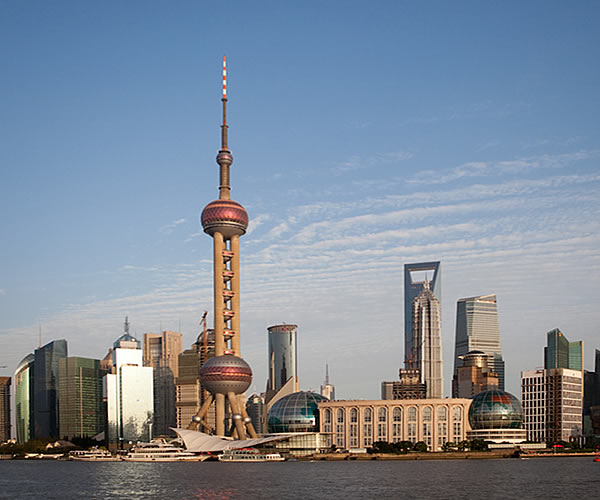
The Chinese Opera is not 'opera' in the sense that we think of it in the West. This fascinating art form combines Chinese folklore, symbolism and drama and includes dancers, singers, clowns and acrobats. Elaborate costumes, traditional make-up and masks make it easy to identify the traditional characters. The Yi Fu Theatre, at 701 Fuzhou Road, Huangpu district, specialises in Chinese Opera performances.
The Shanghai Grand Theatre was designed by the French architect, Jean-Marie Charpentier and is located on Central Boulevard / Huangpi Road South, in the northern part of the People's Square. Opened in August 1998, the theatre now hosts operas, musicals, ballets, symphonies, chamber music concerts, spoken drama and Chinese operas. The Shanghai Grand Theatre building contains three separate theatres: the 1800-seat Lyric Theatre, the Drama Theatre with 750 seats and the smaller Studio Theatre with 300 seats.
The Shanghai Concert Hall, located at No. 523 Yan'an Road (E) in the Huangpu district, was built in 1930 in classical European style. The city's major orchestras, including the Shanghai Symphony Orchestra, Shanghai Broadcasting Symphony Orchestra, Shanghai Opera, Shanghai Traditional Chinese Orchestra and Shanghai National Music Ensemble have chosen the concert hall as their regular venue and it also plays host to visiting orchestras and performers from around the world.
Details of concerts and cultural events are available in English on the Shanghai Cultural Information website.
Shanghai Museum
Located on the People's Square in the Huangpu District, the Shanghai Museum houses a comprehensive collection of ancient Chinese art, including celebrated collections of ceramics, paintings and calligraphy. The museum was originally founded in 1952 and quickly developed into a major centre for research and preservation. In 1992, the Shanghai municipal government allocated the museum the land for its current location, and the new museum building was opened in 1996 after three years of construction. The museum houses eleven permanent galleries, as well as three halls for temporary exhibitions.
The Bund
The Bund is one of the most famous tourist destinations in Shanghai and is protected from the adverse effects of new development by rigorously imposed height restrictions for new buildings in the area. Its buildings represent many architectural styles, including Art Deco, Neo-Classical, Gothic, Renaissance and Romanesque and most have remained largely unchanged externally since the 1930s. Shanghai has one of the largest concentrations of Art Deco architecture in the world, thanks to the huge growth of the city in the 1920s and 1930s. The buildings originally housed banks, consulates and the headquarters of most of the major financial institutions operating in Asia. The Bund was also home to the Shanghai Club, located at no.3 the Bund, which was the meeting place of choice for British expats in years gone by.
Yuyuan Gardens
Considered to be amongst the finest gardens in China, the Yuyuan gardens have had a troubled history. Since they were first established in 1559, they have seen periods of neglect, occupation of the Town God Temple by the British during the Opium Wars in 1842, occupation of the gardens by Chinese troops during the Taiping Rebellion and damage caused by the Japanese in 1942. The Shanghai government undertook the task of restoring the gardens to their former glory between 1956 and 1961, after which they were opened to the public. Yuyuan garden occupies 2 hectares and includes six areas:
- Grand Rockery - including caves, gorges and cliffs reaching up to 12 metres high
- Sansui Hall - built in 1760 as a place to entertain guests, it is the largest structure in the garden
- Inner Garden - first laid out in 1709, with rockeries, ponds, pavilions and towers
- Jade Magnificence Hall - furnishings include rosewood pieces from the Ming dynasty
- Lotus Pool - includes a pavilion in the lake
- Ten Thousand Flower Tower Garden - has areas separated by tile edged walls, each ending in a dragon's head
Jing'an Temple
Constructed in 247 AD, the Jing'an temple predates the founding of the city of Shanghai in 1292. Originally built beside the Suzhou Creek, the temple was relocated to its current position in 1216. The current temple was rebuilt during the Qing Dynasty. During the Cultural Revolution, it was used as a plastics factory. It was converted back into a Buddhist temple in 1983 and completely renovated in 2003.
The temple houses the Hongwu Bell, a Ming Dynasty copper bell weighing 3.5 tons. The largest sitting jade Buddha in the country, at 3.8 metres, can be admired in the Jade Buddha Hall of the temple.
Address: No.1686, Nanjing Road W.
Opening Hours: 7am to 5pm
Longhua Temple
Longhua Park, located on the Longhua Road in the south of Shanghai, is famed for its temple and pagoda. Built in 242 AD, Longhua is the oldest temple in Shanghai, as well as the largest. A huge, three-metre high copper bell, weighing five tons, is struck in a ceremony on 31st December each year, to mark the coming of the New Year. In front of the temple, the Longhua Pagoda stands 40 metres high. The pagoda has been rebuilt several times but still remains in the style of the Song Dynasty. The temple complex is particularly crowded in late spring, when the peach trees are in bloom and the temple fair takes place.
Opening Hours: 7am to 4.30pm
Update 24/11/2006

Babbel is an international success with millions of active subscribers and ranked as the world's #1 innovative company in education.
Why Babbel?
Learn and review on your own schedule: Mobile, tablet or desktop compatible, with lessons about 10-15 min.
Expert-made courses: Learn the basics or focus on topics like travel, culture, or business.
Start speaking right away: Learn to speak a new language naturally and conversationally.
Every learner is different: Each course is based on your native language and personal interests.
Remember everything: Babbel employs proven cognitive techniques that move new vocab to your long-term memory.
Refine your pronunciation: Practise speaking and improve your pronunciation with speech recognition technology.
Try Babbel for free today
Registration with Babbel is completely free of charge and the first lesson in every course is FREE to try (Depending on the language you choose, that's 30-80 free lessons!).
If you want full access to Babbel's courses, simply choose a subscription that works best for you. Buy with confidence: 20-day money back guarantee!
